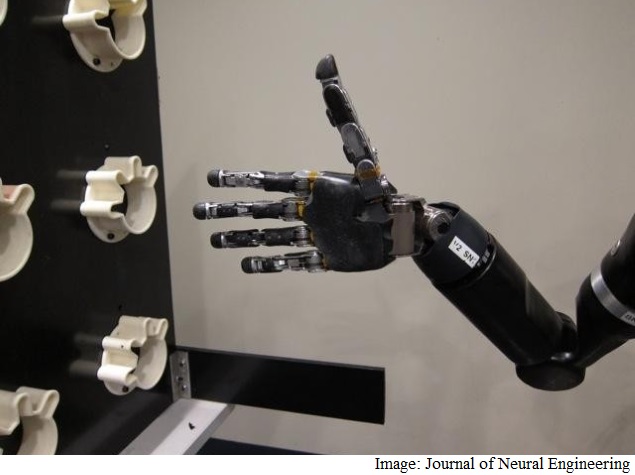- Home
- Science
- Science News
- Researchers Enable Paralysed Woman to Control Robotic Arm With Thoughts
Researchers Enable Paralysed Woman to Control Robotic Arm With Thoughts

Pittsburgh-based Jan Scheuermann, 55, who is paralysed from the neck down since 2003 due to a neuro-degenerative condition, has gone from giving "high fives" to the "thumbs-up" after increasing the manoeuvrability of the robotic arm from seven dimensions (7D) to 10 dimensions (10D).
The extra dimensions come from four hand movements finger abduction, a scoop, thumb extension and a pinch and have enabled Scheuermann to pick up, grasp and move a range of objects much more precisely than with the previous 7D control.
"10D control allowed her to interact with objects in different ways just as people use their hands to pick up objects depending on their shapes and what they intend to do with them," said the study's co-author Jennifer Collinger.
After her eligibility for a research study was confirmed in 2012, Scheuermann underwent surgery to be fitted with two quarter-inch electrode grids. Each was fitted with 96 tiny contact points in the regions of Scheuermann's brain that were responsible for right arm and hand movements.
After the electrode grids in Jan's brain were connected to a computer, creating a brain-machine interface (BMI), the 96 individual contact points picked up pulses of electricity that were fired between the neurons in Scheuermann's brain.
Computer algorithms were used to decode these firing signals and identify the patterns associated with a particular arm movement such as raising the arm or turning the wrist.
By simply thinking of controlling her arm movements, Scheuermann was able to make the robotic arm reach out to objects, as well as move it in a number of directions and flex and rotate the wrist.
It also enabled Scheuermann to "high five" the researchers and feed herself dark chocolate.
The researchers used a virtual reality computer programme to calibrate Jan's control over the robotic arm. They discovered that it is crucial to include virtual objects in this training period to allow reliable and real-time interaction with objects.
"We hope to repeat this level of control with additional participants and to make the system more robust, so that people who might benefit from it will one day be able to use brain-machine interfaces in daily life," Collinger noted.
The findings appeared in the Journal of Neural Engineering.
Catch the latest from the Consumer Electronics Show on Gadgets 360, at our CES 2026 hub.
Related Stories
- Samsung Galaxy Unpacked 2025
- ChatGPT
- Redmi Note 14 Pro+
- iPhone 16
- Apple Vision Pro
- Oneplus 12
- OnePlus Nord CE 3 Lite 5G
- iPhone 13
- Xiaomi 14 Pro
- Oppo Find N3
- Tecno Spark Go (2023)
- Realme V30
- Best Phones Under 25000
- Samsung Galaxy S24 Series
- Cryptocurrency
- iQoo 12
- Samsung Galaxy S24 Ultra
- Giottus
- Samsung Galaxy Z Flip 5
- Apple 'Scary Fast'
- Housefull 5
- GoPro Hero 12 Black Review
- Invincible Season 2
- JioGlass
- HD Ready TV
- Laptop Under 50000
- Smartwatch Under 10000
- Latest Mobile Phones
- Compare Phones
- Vivo Y500i
- OnePlus Turbo 6V
- OnePlus Turbo 6
- Itel Zeno 20 Max
- OPPO Reno 15 Pro Mini 5G
- Poco M8 Pro 5G
- Motorola Signature
- Vivo Y50e 5G
- Lenovo Yoga Slim 7x (2025)
- Lenovo Yoga Slim 7a
- Realme Pad 3
- OPPO Pad Air 5
- Xiaomi Watch 5
- Huawei Watch 10th Anniversary Edition
- Acerpure Nitro Z Series 100-inch QLED TV
- Samsung 43 Inch LED Ultra HD (4K) Smart TV (UA43UE81AFULXL)
- Asus ROG Ally
- Nintendo Switch Lite
- Haier 1.6 Ton 5 Star Inverter Split AC (HSU19G-MZAID5BN-INV)
- Haier 1.6 Ton 5 Star Inverter Split AC (HSU19G-MZAIM5BN-INV)
-
 ISRO’s PSLV Suffers Second Failure as Third-Stage Glitch Sends Rocket Off Course
ISRO’s PSLV Suffers Second Failure as Third-Stage Glitch Sends Rocket Off Course
-
 NASA Confirms First Medical Evacuation in ISS’s 25-Year History
NASA Confirms First Medical Evacuation in ISS’s 25-Year History
-
 Space Forge Tests World’s First Commercial Semiconductor Factory in Space
Space Forge Tests World’s First Commercial Semiconductor Factory in Space
-
 83rd Golden Globe Awards Full List of Winners: Hamnet, The Pitt, Adolescence, and More
83rd Golden Globe Awards Full List of Winners: Hamnet, The Pitt, Adolescence, and More











